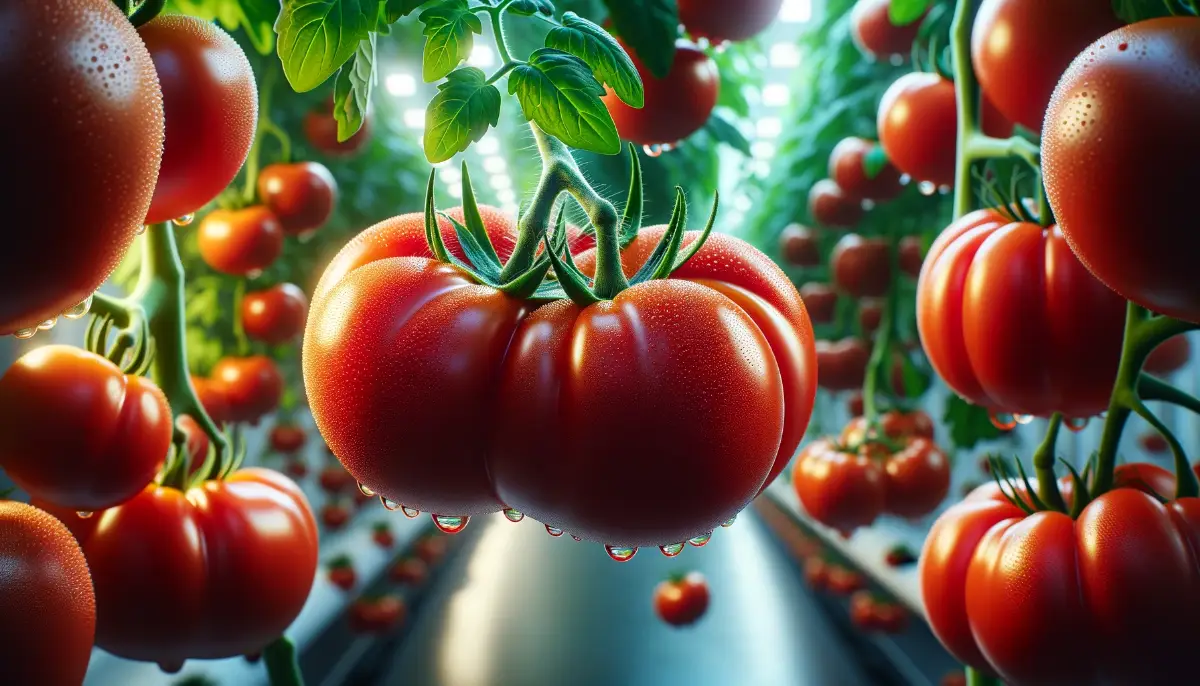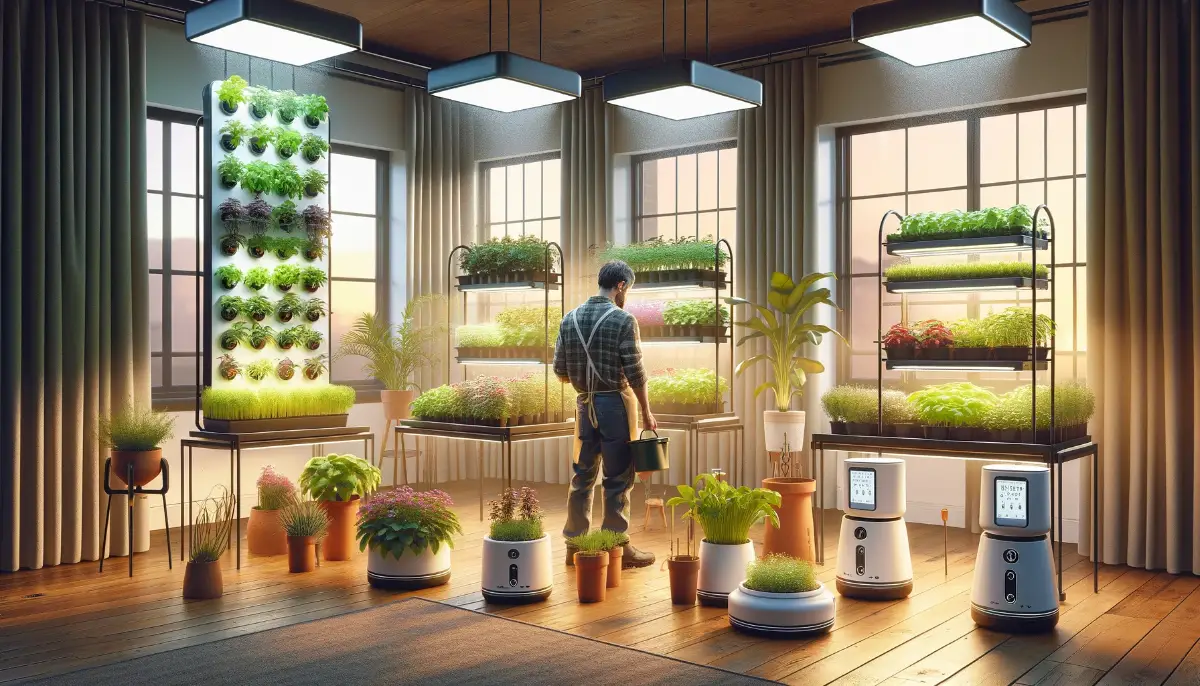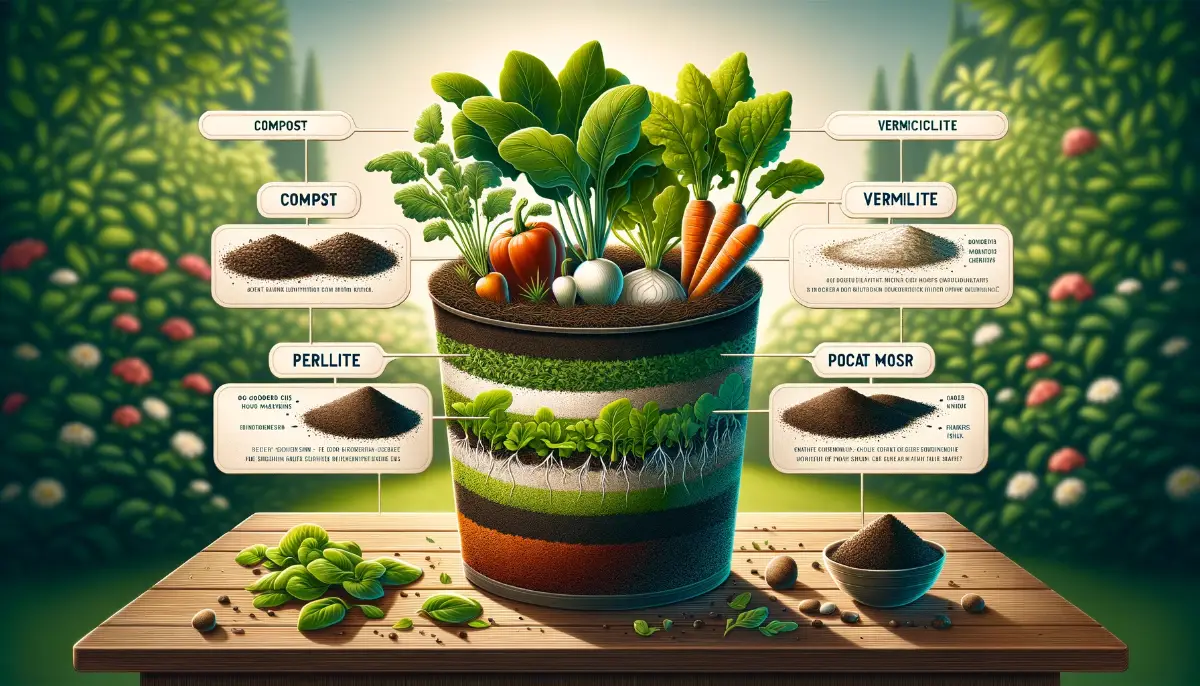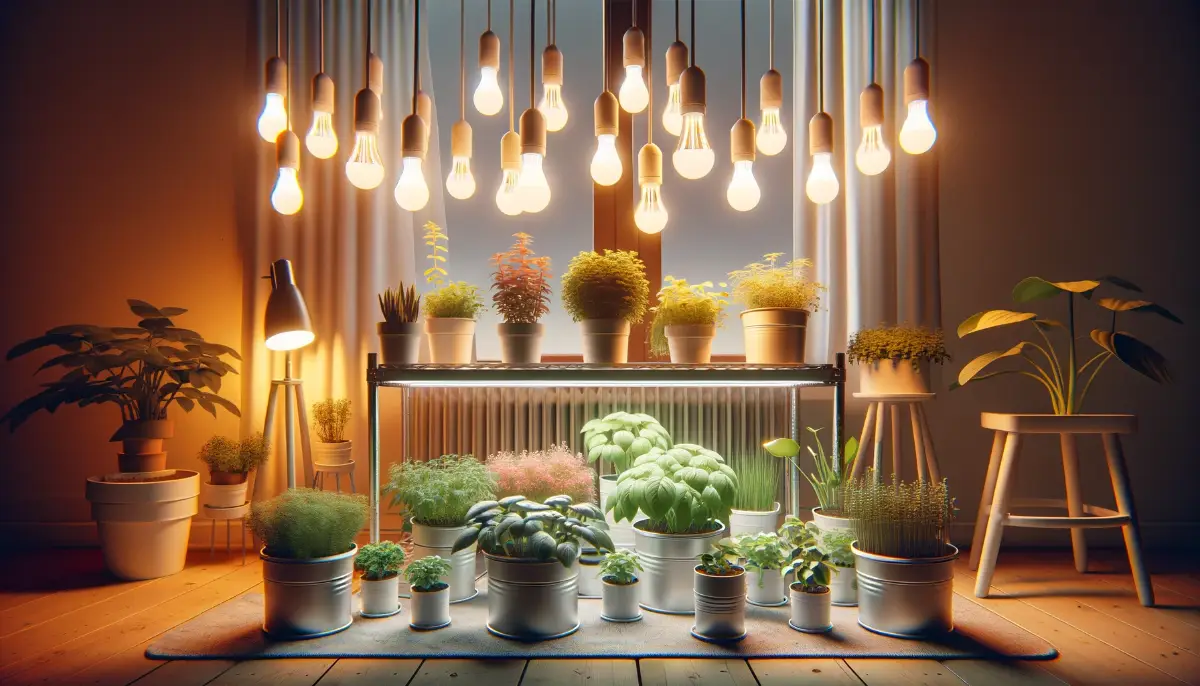Growing organic tomatoes indoors isn’t just about having fresh produce at your fingertips year-round; it’s about embracing the joy of gardening in any living space, regardless of size.
Whether you’re in a small apartment with just a window sill or a larger home with room for indoor grow lights, the process of nurturing tomato plants from seed to fruit is rewarding and, surprisingly, accessible.
The beauty of indoor tomato gardening lies in its adaptability. With the right setup, a bit of knowledge, and regular care, you can cultivate a lush, productive mini-garden that brings both flavor and color to your indoor environment.
Let’s dive into the essentials of starting your indoor tomato garden, from selecting the right varieties to understanding the basics of care and maintenance.
- Selecting suitable tomato varieties is crucial for indoor gardening success. Dwarf and micro-dwarf varieties are often best for small spaces.
- Proper care is essential, including adequate watering, sufficient lighting, optimal temperature control, and regular fertilization.
- Effective pollination techniques are necessary for fruit production in the absence of natural pollinators.
Getting Started with Indoor Tomato Plants
Selecting the Right Tomato Varieties
Not all tomatoes are suited for indoor cultivation. Space constraints and lighting conditions inside homes make dwarf and micro-dwarf varieties the stars of indoor gardening.
These plants are bred for their compact size and are perfect for container gardening, requiring less room to grow while still producing delicious, full-sized tomatoes. When selecting varieties, consider the flavor profile, fruit size, and growth habit to match your personal preferences and space availability.
Setting Up Your Tomatoes Garden
Choosing Containers and Growing Mediums
The foundation of any good indoor garden is the right container and growing medium. Opt for pots with good drainage to prevent waterlogging, which can lead to root rot. While traditional potting soil works well, hydroponic systems offer an exciting, soilless alternative for indoor gardeners, potentially speeding up growth and increasing yields.
Lighting and Temperature Requirements
Adequate lighting is the lifeline of indoor tomato plants. Since natural sunlight might be limited depending on the placement of your garden, investing in quality grow lights is crucial. LED grow lights are favored for their efficiency and ability to mimic the sun’s spectrum.
Position your lights so they cover all plants evenly, and maintain them on for about 16 hours a day to simulate the long days of summer. This promotes strong, healthy growth and ensures your plants receive the energy they need for fruit production.
Tomatoes prefer a warm environment, with daytime temperatures around 65°F to 85°F (18°C to 29°C) and slightly cooler at night. This temperature range encourages growth and fruit setting. Humidity is another factor to consider; too much can promote fungal diseases, while too little can stress plants and inhibit pollination. Aim for a humidity level between 40% and 60%, using a humidifier or dehumidifier to maintain these conditions.
Watering and Feeding Your Indoor Tomatoes
Water management is key to healthy tomatoes. Overwatering is a common issue in indoor gardening, so ensure your containers have good drainage and water only when the top inch of soil is dry. Complement your watering regime with a balanced, organic fertilizer to nourish your plants throughout their growth cycle.
Pollination and Air Circulation
In the great outdoors, tomatoes are pollinated by wind and insects. Indoors, you may need to lend a hand by gently shaking the plants to mimic the wind or using a small paintbrush to transfer pollen from flower to flower. Good air circulation, achievable with a fan, can also help with pollination and prevent disease by keeping the foliage dry.
With patience and care, your indoor tomato garden will become a source of pride, beauty, and delicious produce.
Advanced Care Techniques
Pruning for Prosperity
Pruning your indoor tomatoes is essential for encouraging air circulation and directing energy towards fruit production. Remove suckers, which are small shoots that appear in the axils of leaves, to prevent the plant from becoming bushy and to focus its energy on developing a strong central stem and fruit. Additionally, remove any yellowing or diseased leaves to keep the plant healthy and improve air flow around it.
Support Structures: Keeping Up Appearances
As your tomato plants grow, they’ll need support to hold up the weight of their fruit. Stakes, cages, or trellises not only prevent the plants from sprawling on the ground but also facilitate air circulation and reduce disease risks. Secure your plants gently to these supports using soft ties, taking care not to damage the stems.
Fertilization Schedule
Fertilization is a key component of growing healthy, productive organic tomatoes indoors. A well-planned fertilization schedule ensures your tomato plants receive the necessary nutrients at the right times during their growth cycles. Here’s a guide to help you create an effective fertilization plan for your indoor organic tomato garden.
Initial Planting Stage
- At Planting: Mix a well-balanced organic compost into your potting soil before planting. This gives your tomatoes a nutritious start. Consider a compost that includes plenty of organic matter, such as worm castings, which release nutrients slowly and improve soil structure.
Seedling Stage
- 2 Weeks After Planting: Once your tomato seedlings have established themselves and have at least two sets of true leaves, begin a light feeding regimen. Use a diluted, water-soluble, organic fertilizer that is higher in nitrogen to encourage strong leaf and stem growth. A ratio of 2-1-2 (N-P-K) is ideal for this stage. Apply according to the product instructions, typically every 2 weeks.
Flowering and Fruit Setting Stage
- As Flowers Appear: Transition to a fertilizer that is higher in phosphorus and potassium to support flower formation and fruit setting. A 1-3-2 ratio is suitable for this phase. The increased phosphorus helps with the development of the flowers, which turn into tomatoes, while potassium strengthens the plant’s overall systems.
- Regular Feeding: Continue applying this fertilizer every 2-3 weeks throughout the fruiting stage. Be careful not to over-fertilize, as this can lead to lush foliage at the expense of fruit production.
Peak Harvesting Period
- During Peak Harvest: As your tomatoes begin to ripen, you may switch to a potassium-rich, lower-nitrogen fertilizer to support fruit ripening and improve taste. A 1-3-4 ratio works well. Potassium plays a key role in the development and ripening of tomatoes, enhancing both the quantity and quality of your harvest.
Additional Tips
- Monitor Plant Health: Keep an eye on your plants for signs of nutrient deficiencies or excesses (e.g., yellowing leaves, stunted growth, or leaf burn) and adjust your fertilization schedule as needed.
- Organic Options: There are many organic fertilizers on the market specifically formulated for tomatoes. You can also consider making your own compost tea or using fish emulsion as natural, effective fertilizers.
- Soil Testing: Consider conducting a soil test periodically to understand the nutrient levels in your potting mix. This can help you adjust your fertilization approach for optimal plant health.
By following a tailored fertilization schedule and paying close attention to the needs of your indoor tomato plants, you can ensure a bountiful harvest of delicious, organic tomatoes right from your own home. Remember, the key to successful indoor gardening is not just providing your plants with the right nutrients but also observing and adjusting to their responses for continual improvement.
Troubleshooting Common Problems
Growing organic tomatoes indoors can be rewarding, yet it comes with its own set of challenges. Below are common problems you might encounter, along with solutions to keep your indoor tomato garden thriving.
Insufficient Light
Problem: Tomato plants require 6-8 hours of direct sunlight per day. Indoor environments often fall short of this requirement, leading to leggy plants, slow growth, or poor fruit production.
Solution: Supplement natural light with grow lights. LED or fluorescent grow lights are great options. Place the lights close to the plants, about 2-4 inches above the top of the plants, and keep them on for 14-16 hours a day to mimic the natural daylight they crave.
Overwatering or Underwatering
Problem: Tomatoes are sensitive to their watering schedule. Overwatering can lead to root rot and fungal diseases, while underwatering stresses the plant, affecting yield and health.
Solution: Ensure your containers have good drainage and water your plants when the top inch of soil feels dry to the touch. Using a moisture meter can also help take the guesswork out of watering. Consistency is key.
Temperature Fluctuations
Problem: Tomatoes prefer consistent temperatures between 65°F and 85°F. Indoor environments can sometimes be too cool, especially at night, which can inhibit growth and fruit setting.
Solution: Keep your garden in a room with stable temperature control. If needed, use a small space heater or a heat mat under your plants to maintain optimal growing conditions.
Pollination Issues
Problem: Without natural pollinators like bees and wind, indoor tomatoes may struggle with fruit set.
Solution: Hand pollinate your flowers by gently shaking the plants to mimic the action of wind or use a small paintbrush to transfer pollen from one flower to another.
Nutrient Deficiencies
Problem: Yellow leaves, stunted growth, or poor fruit development can indicate a nutrient imbalance.
Solution: Use a balanced organic fertilizer and adjust based on plant response. A soil test can provide specific insights. For example, yellowing leaves can indicate a nitrogen deficiency, requiring a higher nitrogen fertilizer.
Pests and Diseases
Problem: Indoor tomatoes can still be vulnerable to pests like aphids, spider mites, and whiteflies, as well as diseases such as powdery mildew and blight.
Solution: Regularly inspect plants for signs of pests or disease. Use organic pest control methods such as neem oil or insecticidal soap. Increase air circulation and reduce humidity to prevent fungal diseases. Remove and dispose of any infected plant parts immediately to prevent spread.
Blossom Drop
Problem: Flowers fall off without producing fruit, often due to high temperatures or insufficient light.
Solution: Ensure adequate lighting and maintain a consistent, comfortable temperature around your plants. Avoid sudden temperature changes.
By closely monitoring your plants and responding promptly to any signs of trouble, you can successfully manage these common issues and enjoy a healthy, productive indoor tomato garden. Remember, every problem has a solution, and part of the joy of gardening is learning and adapting to ensure the success of your plants.
FAQs for Indoor Tomatoes
What are the best tomato varieties for indoor gardening?
Dwarf and micro-dwarf varieties, such as Tiny Tim, Red Robin, and Yellow Canary, are ideal for indoor gardening due to their compact size and adaptability to container growing.
How much light do indoor tomato plants need?
Indoor tomato plants require 6-8 hours of direct sunlight daily. If natural light is insufficient, supplement with LED or fluorescent grow lights, keeping them on for 14-16 hours a day.
What is the optimal temperature for growing tomatoes indoors?
The optimal temperature range for indoor tomatoes is between 65°F and 85°F during the day, with a slight drop at night. Consistent temperatures within this range promote healthy growth and fruit production.
How often should I water my indoor tomato plants?
Water when the top inch of soil feels dry to the touch, typically once every 1-2 days, depending on the air humidity and temperature. Avoid overwatering to prevent root rot.
What type of fertilizer should I use for indoor tomatoes, and how often?
Use a balanced, organic liquid fertilizer every 2-4 weeks. Switch to a tomato-specific fertilizer that is higher in phosphorus during the flowering and fruiting stages to support fruit development.
How can I pollinate tomato plants indoors without insects?
Gently shake the flowering branches to mimic the wind or use a small paintbrush to transfer pollen from one flower to another. This manual pollination mimics the natural pollination process.
How do I prune indoor tomato plants?
Remove suckers (the shoots that grow in the leaf axils) to encourage more fruit production instead of foliage. Also, trim any leaves touching the soil to prevent disease.
What are common pests and diseases for indoor tomatoes, and how can I manage them?
Common pests include aphids, spider mites, and whiteflies. Use insecticidal soap or neem oil for control. For diseases like powdery mildew, ensure good air circulation and avoid wetting the leaves when watering.
Can I grow tomatoes indoors in winter?
Yes, with adequate light from grow lights and consistent temperature control, you can grow tomatoes indoors during winter.
How do I ensure my indoor tomatoes are truly organic?
Use organic seeds or seedlings, organic potting soil, and organic fertilizers. Avoid using chemical pesticides or herbicides, opting for natural pest control methods instead.










